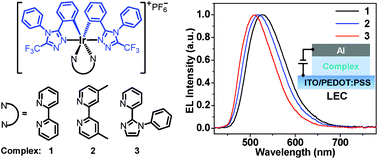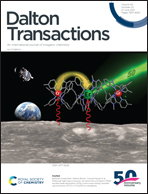Green to blue-green-emitting cationic iridium complexes with a CF3-substituted phenyl-triazole type cyclometalating ligand: synthesis, characterization and their use for efficient light-emitting electrochemical cells†
Abstract
Green to blue-green-emitting cationic iridium complexes free of sp2 C–F bonds, namely [Ir(CF3-dPhTAZ)2(bpy)]PF6 (1), [Ir(CF3-dPhTAZ)2(dmebpy)]PF6 (2) and [Ir(CF3-dPhTAZ)2(phpyim)]PF6 (3), have been designed and synthesized with 3,4-diphenyl-5-(trifluoromethyl)-4H-1,2,4-triazole (CF3-dPhTAZ) as the cyclometalating ligand (C^N) and 2,2′-bipyridine (bpy), 4,4′-dimethyl-2,2′-bipyridine (dmebpy) or 2-(1-phenyl-1H-imidazol-2-yl)pyridine (phpyim) as the ancillary ligand (N^N). In CH3CN solution, complexes 1–3 afford green to blue-green emission centered at 521, 508 and 498 nm, respectively. The electron-withdrawing CF3 group attached at the triazole ring in CF3-dPhTAZ largely blue-shifts (by over 20 nm) the emission of the complex through stabilizing the highest occupied molecular orbital. In doped films, the complexes afford sky-blue emission with near-unity phosphorescent efficiencies. In neat films, the complexes show largely suppressed phosphorescence concentration-quenching, with phosphorescent efficiencies of up to 0.66. Theoretical calculations reveal that the emission of the complexes can arise from either charge-transfer (Ir → C^N/C^N → N^N) or C^N/N^N-centered 3π–π* states, depending on the local environment of the complexes. Solid-state light-emitting electrochemical cells (LECs) based on the complexes afford green to blue-green electroluminescence centered at 525, 517 and 509 nm, respectively, with high current efficiencies of up to 35.1 cd A−1. The work reveals that CF3-dPhTAZ is a promising C^N ligand free of sp2 C–F bonds for constructing efficient cationic iridium complexes with blue-shifted emission.



 Please wait while we load your content...
Please wait while we load your content...